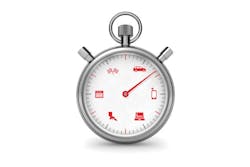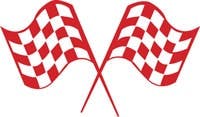Rob Grieve, owner of Nylund’s Collision Center in Englewood, Colo., had a problem at an otherwise successful shop.
He had a parking lot overflowing with high-end vehicles—Audi, Mercedes, Lexus and others. He prides the $2-million-a-year, Denver-area shop on taking care of customers. But with such a full lot, he knew he needed to find a way to move vehicles faster, or he wouldn’t be able to get vehicles delivered on time.
Grieve evaluated the workload and realized many of the cars only needed light work—a bumper replacement or a new pickup bedside. He had many vehicles that were only one- or two-day jobs.
So, he turned to a simple, yet powerful, process: pre-painting parts before scheduled repairs.
“Things seem to get a little jammed up from time to time,” he says. “You kind of have to keep it under control somehow.”
Grieve says when he began pre-painting parts, one-day jobs turned into one-hour jobs. Insurance companies love the process because they don’t have to pay for rental cars, and customers are happy that their life is disrupted as little as possible. Plus, the efficiency gains lead to greater productivity and increased revenue.
While the concept seems simple, all the right pieces have to fall into place for pre-painting to work. You need the right parts at the right time, you need the precise color match, and everyone from the customer to the parts manager has to be on the same page.
FenderBender spoke with shop owners and industry experts about how to use this process to boost efficiency. The result is this step-by-step guide to pre-painting parts that is sure to improve key performance indicators (KPIs) and customer satisfaction in your shop.
STEP 1: Examine the vehicle. When a vehicle arrives at your shop, the estimator has to determine whether the repair is a light job and whether the vehicle is drivable. To be a candidate for pre-painting, the repair should take an hour or less to complete, so customers don’t have to wait. A proper estimate is crucial, as discovering additional damage when the car is in for repair will negate the whole process.
While the car is in the shop, be sure to write down part numbers and take photos of what you’re replacing to make sure you’re ordering parts accurately. Check on parts availability to ensure you can quickly get what you need.
You will also need to make sure you can match the vehicle’s paint. Grieve suggests taking the gas tank door off the car to match the color perfectly.
STEP 2: Explain the process to the customer. You’ll need to plan with the customer to let them know what the repair process will look like, says Thad Green, business development manager at BASF. The shop will need to provide a timeline for parts ordering, painting and the final assembly.
“You’re pre-managing the repair process up front,” Green says. “You’re also setting expectations with the customer.”
Tim Kilkeary, owner of Kilkeary’s Auto Body in Eighty Four, Pa., says he usually talks with the customer about leaving a deposit so the shop doesn’t get stuck with a part. He asks for $200, an insurance check or a credit card number. The shop doesn’t deposit any funds until the car is completed.
STEP 3: Order the right parts. Green says in order to pre-paint parts for a quick turnaround, all the parts must be accurate and must fit, otherwise the job will take too long.
“You’ve got to get everything laid out and prepared,” he says.
When the part comes in, mirror match it with the pictures to see if it is the correct part. If the part is not accurate or does not fit, then you’re back to where you started. But, Green says, in some cases, shops do business a close drive from their parts vendor. They could go get the part to make sure the job can still be completed as quickly as it possibly can.
“That’s really what it’s about is thinking through the entire process, and the what-if scenarios,” Green says. “You’ve got to put those what-if scenarios in place to get those plan Bs.”
STEP 4: Pre-paint the parts. When it’s time to paint the part, make sure you’ve got the right color by checking your variant deck, shop owners say.
If it’s not a common color, or if it’s a color with multiple variances, they won’t pre-paint the ordered part. They’ll paint the part when the car gets to the shop.
Most small parts can be painted between large jobs, or even at the same time, depending on the shop’s paint system. These parts should take up minimal booth space and not disrupt the shop’s regular workflow.
STEP 5: Schedule the repair. After all of the previous steps are taken, it’s time to call the customer and schedule the repair.
When the repair is scheduled varies depending on the shop, its regular workload, staffing levels and other factors. But Kilkeary says the production manager needs to know when the short jobs are coming in, so he can be sure to allocate the resources to get the repairs done on time. Technicians also need a heads-up, so they aren’t surprised if they’re pulled off another job to work on a light repair for an hour. Any delay is unacceptable, as it defeats the purpose of pre-painting and will leave a shop with unhappy customers.
STEP 6: Finish the job. Depending on what needs to be done, some shops have three people work on the car pit-stop style. The whole idea is to get the job done quickly, so if that means putting more people on the vehicle, then so be it, Kilkeary says. Careful scheduling should prevent a shop from having inadequate staff to complete a light repair on time.
Kilkeary says this entire process helped his $4.5 million-a-year Pennsylvania shop cut cycle time from 10 days to seven. And touch time increased from 1.8 hours to 3.5. The process works because repairs aren’t scheduled until everything is in place to make them happen quickly. If there’s a parts delay, a color-match issue or any other hurdle, it’s addressed before the vehicle drop-off date is set. And if the shop determines a quick repair isn’t possible, that is communicated to the customer.
For Kilkeary, pre-painting has become a great marketing tool.
“The goal is to be able to say we know we can fix your car two days faster than anybody else in the market,” he says.









